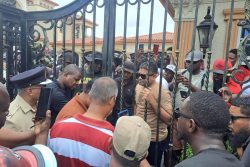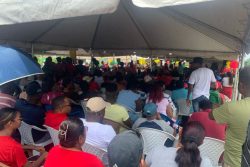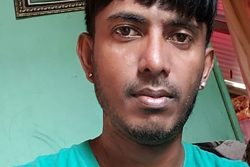A new factor has entered into Guyana’s complicated equation, and this one in a sense comes from left field. It is the appearance of the Corona virus. A woman who had flown in from New York earlier this month died of Covid-19 in the Georgetown Hospital on Wednesday. It was only a matter of time before the virus announced its arrival here, and now that it has, the health authorities can take it for granted that it will spread. The experience from other countries is that it does so quickly, and that community transmission, as it is called, is to be expected.
This particular case was an imported one, but elsewhere in the world it has been shown that nations with far more resources and administrative capabilities than those with which Guyana is blessed, have been unable to stem the spread of the virus even after implementing stringent immigration controls and follow-up interventions related to the contacts of imported cases. That certainly does not mean that these controls should not be enforced; it is simply to say that this approach will not be sufficient on its own to stem the spread of the virus, and that measures directed at dealing with possible widespread community transmission would need to be in place.
At the time the woman who died entered this country, arrivals from the United States were not screened unless they had flu-like symptoms, because the US was not then on the list of high-risk countries. It is now. It was explained to Stabroek News that 400-600 passengers a day were coming in from New York, and that to screen everyone would have been a terrible burden. One can only remark that during the period when the US was not regarded as a high-risk place of origin, it is always possible that other travellers who were asymptomatic at the time but who were nevertheless carrying the virus may have entered Guyana.
This nation’s porous borders will present a real challenge to the authorities, although in addition to the screening of passengers arriving from a growing list of countries, they are patrolling what they term as irregular border crossings. Unfor-tunately, no matter how assiduous these patrols are, anyone determined to evade them and cross into Guyana’s land space can probably find a route to do so. The lawless area of the Cuyuni River comes immediately to mind.
In a statement President Granger outlined the measures which are being taken to prevent the risk of community spread. It can only be repeated, that on the basis of the available evidence from much wealthier countries endowed with far more sophisticated public health systems than that to which Guyana lays claim, have not been able to “prevent” community spread. The UK’s ap-proach, for example, is to first contain the virus, and then delay its transmission, so that huge numbers of cases do not overwhelm the National Health Service all at the same time.
The evidence from South Korea might seem to indicate that testing the population on a large scale suggests itself as the best instrument for controlling its spread in the first instance. Other countries have been slow to follow this example, and it was only on Wednesday, for example, that the British government announced that it was increasing its testing capacity from 1,000 a day to 10,000 a day. And this in a nation with great experience in public health and a long-established free health service catering for everyone.
If Britain was laggard in this area, Guyana could hardly be blamed for any lack of timeliness in terms of this kind of response. However, it transpires that this country with the assistance of PAHO has developed the capacity to test for Covid-19, which is certainly very good news, although whether it could really cope with the volume of testing which would be required should there be a widespread outbreak is perhaps questionable.
And that is the problem. What will really test the system is the degree of the infection in terms of numbers, although measures have clearly been put in place for the management of cases on a less than epidemic scale. The President mentioned the existence of three quarantine facilities, and said that others would be identified. The public was also given to understand that the Ministry of Public Health would fill existing gaps in the system, including with reference to supplies and equipment. The difficulty is that the public health service starts from a very low baseline, and even before having to confront the possibility of a health crisis, it faced complaints about a lack of drugs and equipment in several hospitals. It would not be sufficient, therefore, just to ‘fill the gaps’ for existing needs, and even if it is going beyond that, which it may well be doing, it is probably not calculating for any mass outbreak.
One would also like to know how it is co-ordinating with the private health sector, since the latter will have to be integrated into any response where a large number of cases is involved – and even a small number, since many people will choose to refer themselves to private doctors and hospitals in preference to the public ones. One good sign, however, is that citizens were told the ministry had enough personal protective equipment for health facilities across the country, as well as adequate stores of respiratory medicine for the next three months. In addition, the President said that it was training health-care providers and first responders, and that active surveillance would be heightened.
The other measures the President enumerated were all the standard ones in use in places overseas where Covid-19 has been identified. He also referred to a communications campaign which would keep the population updated on the virus and its impact. What the Health Ministry would need to do is to tell people not just about washing hands, etc, since Corona seems to be spread by droplets, but also about where to go if they think they might have the virus. Anyone with the classic symptoms of a temperature, headache, cough, shortness of breath and the like, needs to know where to go to be tested. If the authorities are to limit the spread of infection, they would not want such a person presenting themselves in a crowded hospital or doctor’s clinic for treatment, or to be tested.
In some countries, if you think you have the virus, you do not go to A&E. There may be arrangements for you to be tested outside the hospital in your car, or in a special unit, or even to be tested at home. In the UK there is a phone number you call for advice on how to proceed. What does the Health Ministry want Guyanese to do? When do they think persons should be tested, or is it that they are of the view that only a health professional should authorise this? If so, which health professional and in what location?
Several European countries have asked citizens who have come back from certain listed countries or who have mild symptoms to self-isolate. On the whole, people have reacted well to this, and have complied. The Minister of Health told the public that no one had been quarantined as yet, since they were waiting for the results of testing before implementing safety measures. However, people would still like to know what those safety measures would involve, and whether there were any plans for self-isolation further down the line, and if so, in what circumstances?
The good news for parents is that children seem relatively unaffected by the virus, and young, healthy people exhibit only very mild symptoms. Those most at risk are the elderly and anyone with an underlying health condition. The bad news for Guyana is the overcrowded living conditions of some deprived urban areas, and some rural ones. Since transmission is facilitated by close contact, the hygiene advisories from the ministry should be punctiliously observed by everyone.
Among other things, the President advised that public gatherings should be discouraged. Perhaps better than all the exhortations to political leaders, the Corona virus might persuade them to keep protestors off the streets.






